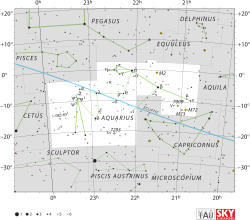| Observation data Epoch J2000 Equinox J2000 | |
|---|---|
| Constellation | Aquarius |
| Right ascension | 22h 43m 35.23307s [1] |
| Declination | −18° 49′ 49.3557″ [1] |
| Apparent magnitude (V) | 4.673 [2] |
| Characteristics | |
| Spectral type | K3 III [3] |
| U−B color index | +1.549 [2] |
| B−V color index | +1.376 [2] |
| Variable type | suspected [4] |
| Astrometry | |
| Radial velocity (Rv) | +21.6 [5] km/s |
| Proper motion (μ) | RA: −31.73 [1] mas/yr Dec.: −28.54 [1] mas/yr |
| Parallax (π) | 7.53±0.26 mas [1] |
| Distance | 430 ± 10 ly (133 ± 5 pc) |
| Absolute magnitude (MV) | −0.93 [6] |
| Details | |
| Radius | 37 [7] R☉ |
| Luminosity | 434.08 [6] L☉ |
| Surface gravity (log g) | 2.06 [8] cgs |
| Temperature | 4,170 [8] K |
| Metallicity [Fe/H] | −0.23 [8] dex |
| Rotational velocity (v sin i) | 10 [9] km/s |
| Other designations | |
| 66 Aqr, BD−19°6324, HD 215167, HIP 112211, HR 8649, SAO 165252 [10] | |
| Database references | |
| SIMBAD | data |
66 Aquarii is a single [11] star in the equatorial constellation of Aquarius. 66 Aquarii is the Flamsteed designation though the star also bears the Bayer designation of g1 Aquarii. [12] It is visible to the naked eye as a faint, orange-hued star with an apparent visual magnitude of 4.673. [2] Based upon an annual parallax shift of 7.53 milliarcseconds, [1] the distance to this star is about 430 light-years (130 parsecs ).
This is an evolved giant star with a stellar classification of K3 III. [3] It has expanded to 37 times the radius of the Sun [7] and is radiating 434 [6] times the luminosity of the Sun from its outer envelope at an effective temperature of 4,170 K. [8] This gives it the orange-hued glow of a K-type star. [13] It is a suspected variable star that ranges in magnitude between 4.66 and 4.71. [4]
